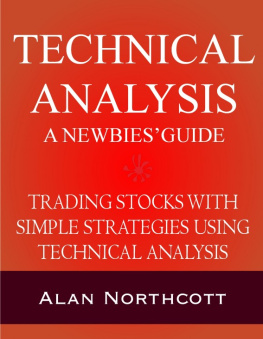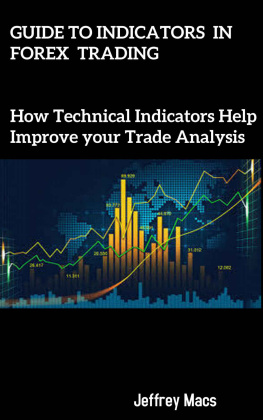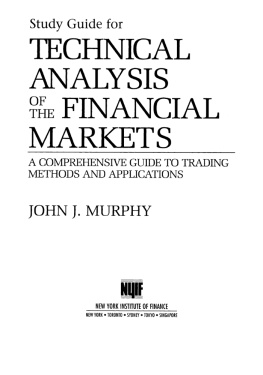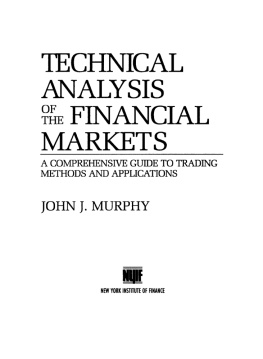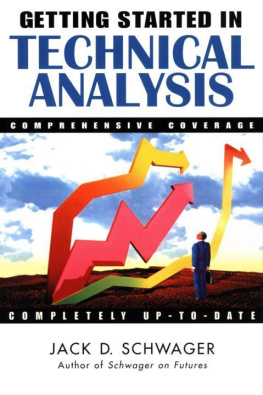Technical Analysis - A Newbies Guide
Trading Stocks with Simple Strategies Using TechnicalAnalysis
Alan Northcott
Published by Alan Northcott at Smashwords
Copyright 2014 Alan Northcott
This ebook is licensed for your personal enjoyment,and may not be re-sold or given away to other people. If you wouldlike to share this book with another person, please purchase anadditional copy for each recipient. Thank you for respecting thehard work of this author.
Disclaimer and Risk Disclosure
By reading this book you agree that this bookand any ideas expressed within is for informational and educationalpurposes only and does not constitute advice or recommendations.Trading in the financial markets, whether for short or long-termpurposes, is risky and may not be suitable for all investors. Youmust understand that you may lose any money invested, and in somemarkets you may lose more than your initial investment.
Before you start trading, you shouldcarefully consider your financial situation, your level ofexperience and knowledge, and your appetite for risk. You couldlose some or all of your trading capital, and you must understandhow to mitigate that risk. No liability is accepted by AlanNorthcott or his successors for any losses whether direct, indirector consequential suffered by the use of any information containedherein.
The information given in this book is foreducational and personal enjoyment purposes only, and is not arecommendation to enter into trading in any form. If any specifictrading or investment or legal advice is required, the services ofa competent and appropriately licensed person should be sought.
Table of Contents
?
Introduction
What istechnical analysis? Is it something for the nerd to revel in and aregular person to be perplexed about?
No, it is actually something that is verysimple in concept, but can be plumbed to great depths. Let us firstget something out of the way. The "technical" in technical analysisdoes not mean that you have to be an A student in mathematics tobe able to understand and use it.
I have an engineering background and amathematical bent. That is probably not surprising. My motherworked in the tax office, would amuse herself on bus journeys bymaking up number puzzles with the serial number of the bus ticket,and would always know exactly how much the bill should be at thelocal supermarket by the time she got to the checkout.
It helped that in England they do not add taxto the total but include it in the article pricing; but to make itharder, those were the days of pounds, shillings, and pence, so noeasy decimal addition.
My father was in banking all his life, andwas a foreign-exchange manager. So you can see that the left sideof my brain was bound to be dominant in my life.
When it came to trading the markets, Inaturally thought that I had a built in advantage. I was wrong.Technical analysis is as much an art as a science, and you cannotjust formally calculate the inevitable winners. No one can.
What you can do is increase your odds ofsuccess. With the markets, much as some may tell you this or that"will happen" if you see a certain signal, nothing is inevitable.At best, the signal means more likely than not.
By increasing your odds of success, onaverage you will choose better and stand to make a decent profitfrom your trading.
Once you accept that you cannot "know"definitively which way the market is going, but only tip theprobabilities in your favor, then you may still be worried that"technical means you have some calculations to perform.
Do not be concerned. Computers and softwaredo all the hard work for a regular trader, and provide all theinformation you need with no mathematical ability necessary. I talkin the book about the calculations that make up the tradingindicators you may use simply so you can understand why they work.You will not even need a calculator to use them.
A.N.
P.S. If you become interested in the moreintuitive side of trading, I recommend a book by Curtis Faith, oneof the original Turtle Traders, called "Trading from Your Gut". Iwrote an endorsement for it, but do not benefit from recommendingit.
P.P.S. Although it is a fascinating read, ifyou are a Newbie I would recommend you getting familiar withconventional technical analysis first before trying out the methodsof Curtiss book.
The Dow Theory
Typically, a discussion of technical analysismust start with the Dow Theory. Charles Dow was one of the fathersof modern trading, and his name is still remembered today in theDow Jones Industrial Average, one of the leading stock marketindices that is often simply called the "Dow".
Dow teamed up with Edward Jones in 1882,forming a business that delivered a handwritten newsletter to banksand brokerages. This became known as the Wall Street Journal in1889, and is still in publication.
Dow wrote many articles about the markets,which always fascinated him, and he decided to put together anaverage of stock values in 1884. To Dow, this provided a readymeans to indicate the health of the business community.
The first average was made up of 11 stocks,nine of which were railroad stocks. In 1896, Dow decided to splitout the transportation stocks into a separate index, and that iswhen the Dow Jones Industrial Average (DJIA) and the Dow JonesTransportation Average (DJTA) came into being.
The new DJIA included 12 stocks and the DJTAhad 20. Dow had shown exceptional insight by recognizing theimportance of tracking individual market sectors.
Dow wrote a lot about his thoughts on thestock market, mainly in the form of editorials published in theWall Street Journal. He died in 1902. He never wrote a book, andthe term "Dow Theory" was coined after his death when his noteswere assembled.
Dows Principles
It is said that Dow never saw hisobservations as a means to trade the stock market, but simply a wayof describing general economic prosperity. Nonetheless, theprinciples that he voiced are still considered valid and applicableto trading. They are usually spelled out as six tenets orprinciples:
1. The averages reflect everything that canbe known about a price.
2. The markets exhibit three types of pricemovement.
3. Primary movements have three phases.
4. It takes both the DJIA and the DJTA toconfirm a trend.
5. Volume must increase in the direction ofthe trend to confirm it.
6. A trend continues until there is a clearreversal.
Averages Reflect Everything
The first principle leads to one of thefundamental beliefs of technical analysis, that the marketdiscounts everything. In other words, the action of the marketreflects everything there is to know about a price.
Dow was speaking about averages because thatwas his focus, but nowadays this principle is applied to individualprices. The idea seems to be simplistic, but turns out to be one ofthe fundamental concepts validating technical analysis.
If you think about it, there are many thingsthat can affect the price of a stock or commodity. Sales areobviously important, as are costs, industrial unrest, governmentlegislation, and the price of raw materials; and the list goeson.
The idea that the market discountseverything allows the technical analyst to ignore the details ofeach of these individual factors, and cut to the bottom line. Afterall, it does not matter which element is changing, supply anddemand control the price, and the outcome is all that the analystis concerned with.
Accepting this makes the job of the analystmuch simpler, indeed it makes it manageable. The reason the priceis moving is not important, you simply need to be able to discernthat it is, and in what direction.
Three Types of Movement

